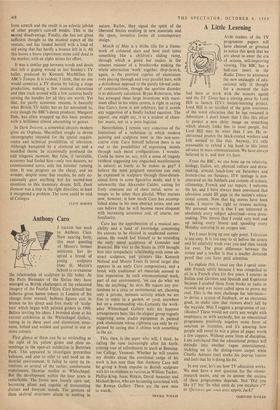Anthony Caro
I TALKED last week to Anthony Caro. Now nearing forty, this most questing of Moore's former assistants has in- spired a brood of
. • • • School to re-examine young sculptors from St. Martin's the relationship of sculpture to life today. At the Paris Biennales of the Sixties they have emerged as British challengers of the exhausted imagery of the Fearful Fifties. Caro himself has hitherto given barest tokens in London of his change from sensual, bulbous figures cast in bronze to his direct and free mode of 'sculp- ture' which began with painted girders in 1960. ‘Before inviting his ideas, I brooded alone at his current exhibition at the Whitechapel Gallery, tuning in to these steel and aluminium struc- tures, bolted and welded and painted in one or more colours.
First glance at them can be as misleading as the sight of his yellow girder and plate as- semblage in the open-air exhibition in Battersea Park. This appeared to investigate precaribus balances, and also to refer to and need an in- dustrial environment. It failed to carry its in- tentions, as several of the earlier, cumbersome experiments likewise misfire at Whitechapel. But the development within the four years is remarkable. The forms now loosely open out, becoming pliant and capable of transmitting distinct and buoyant moods. The gestures of these skeletal structures allude to nothing in
nature. Rather, they signal the spirit of the liberated Sixties exulting in new materials and the spare, inventive forms of contemporary design.
Month of May is a blithe title for a frame- work of coloured slats and bent steel tubes something like a children's sliding ramp, through which a green bar snakes in the sinuous manner of a brushstroke making the whole abstraction 'work' together. Hop-Scotch, again, is the prettiest caprice of aluminium rods playing through and over parallel bars, with a skittishness opposed to the purely formal order of constructivism, though the sportive disorder is as delicately calculated. Bryan Robertson, who has arranged these large inventions with maxi- mum effect in his white cavern, is right in saying that Caro's form is not arbitrary, but it avoids any suggestion of a finally locked equation. The appeal, one might say, is to a student of cham- ber music, not to a pure logician.
Nevertheless, I remain very conscious of the limitations of a technique in which modern painting and sculpture meet in this non-asso- ciative style. Caro himself believes there is no end to the possibilities of expressing moods through such metal configurations. I wonder. Could he move us, say, with a sense of tragedy (without suggesting any anguished manifestation in nature) as Surely as he makes us gay? I believe the most poignant emotions can only be expressed in sculpture through three-dimen- sional form in some figurative mode, and it is noteworthy that Alexander Calder, cutting his lively creatures out of sheet metal, never at- tempts to be other than playful. What matters now, however, is how much Caro has accomp- lished alone in his own abstract terms, and one can believe that he will become more eloquent with increasing assurance and, of course, our familiarity.
Caro has the apprehension of a musical sen- sibility and a fund of knowledge concerning his sources to be elicited in unaffected conver- sation. He would feel himself to be extending the early metal sculptures of Gonzales and Brancusi. His visit to the States in 1959 brought him into sympathetic relationship with some ab- stract sculptors, and painters like Kenneth Noland and Morris Louis (a metal target disc appears in an early Caro composition), and a break with traditional art materials seemed to him imperative. In such unconventional work, part of our environment, 'we can do what we like, do anything,' he says. He rejects any pre- tensions to a civic or monumental art, claiming only a private, intimate activity which we are free to enjoy in a garden, or yard, anywhere but on a commanding site. Certainly the work- aday Whitechapel Gallery suits his happiest arrangements here, like the elegant group vaguely suggesting some studio equipment in painted pink aluminium whose rightness can only be ex- plained by saying that it chimes with something in the air.
This, then, is the piper who will, I think, be calling the tune increasingly after his forth- coming tour of refreshment to teach at Benning- ton College, Vermont. Whether he will resolve my doubts about the emotional range of his work is less sure than that Anthony Caro will be giving a fresh impulse to British sculpture with his ex-students as various as William Tucker, Phillip King, Isaac Witkin, David Annesley and Michael Bolus, who are becoming associated with the Rowan Gallery. These are the new men to watch.
NEVILE WALLIS










































 Previous page
Previous page